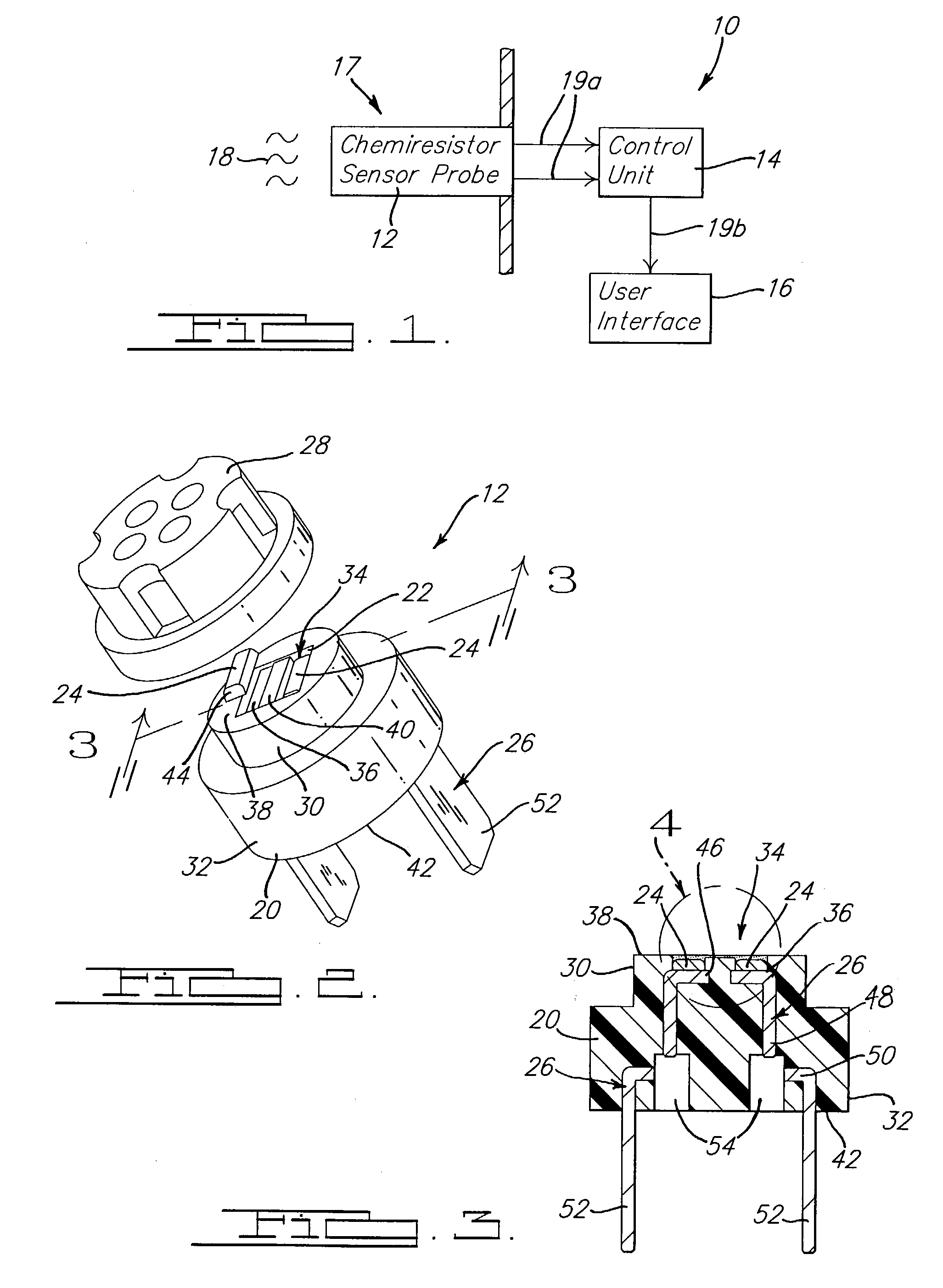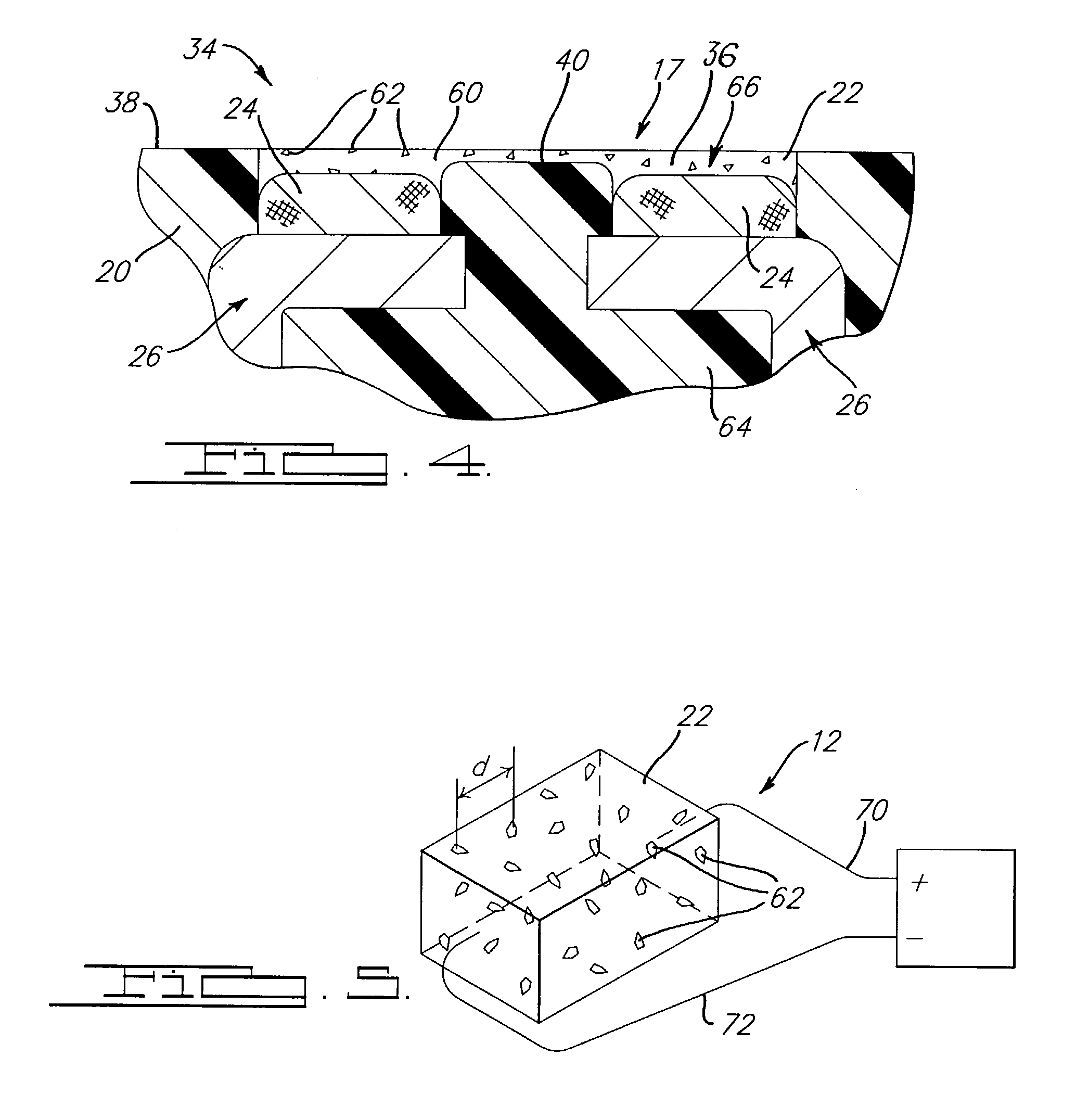Vapor sensor and materials therefor
a technology of vapor sensor and sensor, applied in the field of sensor film, can solve problems such as film volumetric chang
- Summary
- Abstract
- Description
- Claims
- Application Information
AI Technical Summary
Problems solved by technology
Method used
Image
Examples
example 1
[0053]A sensor film having a dimethylsiloxane polymer matrix with conductive carbon black and alkyl substituted siloxane oil is prepared by admixing the following materials: 85 parts by weight SP2224A (a first dimethylsilicone polymer having vinyl polymer and platinum available as a two-part system from SSP); 15 parts by weight (15 phr) polyOctylMethylsilicone oil; and 75 parts by weight N762 (a prior art carbon black available from Cabot Corporation having an N2 value of 28 m2 / g and a DBP of 65 ml / g), where the ingredients were mixed for 15 minutes in a Brabender® mixer to form a first mixture. A second mixture is formed by adding to a Brabender® mixture: 85 parts by weight SP2224B (a second dimethylsilicone polymer having hydride polymer as the second part of a two-part system from SSP); 15 parts by weight (15 phr) polyOctylMethylsilicone oil; and 75 parts by weight N762, where the ingredients are mixed for 15 minutes in a Brabender® mixer to form a second mixture. The first and s...
example 2
[0054]A sensor film having a cross-linked large hydrocarbon side group substituted siloxane polymer matrix with large particle size conductive carbon black is prepared by adding the following materials into a mixer: 96.9 parts by weight VAT-4326 a (3–5% vinylmethylsiloxane)-(35–40% octylmethylsiloxane)-(dimethylsiloxane) terpolymer available from Gelest; 3.1 parts by weight HES 992 (a polyethylhydrosiloxane curing agent from Gelest); 0.1 parts by weight SIP 6829 (a platinum carbonyl cyclovinylmethylsiloxane catalyst complex); and 50 phr (parts per hundred resin) of Asahi 15HS (a large particle size carbon black available from Asahi Carbon Company having an N2 value of 14 m2 / g and a DBP of 85 ml / g). The materials are mixed in a Brabender® mixer for 15 minutes at 30° C. and 80 rpm to form a matrix mixture. The mixture is then applied in a groove over electrodes in a sensor structure by a doctor blade. The sensor structure having the matrix mixture applied is then cured for 3 hours at ...
example 3
[0055]A sensor film having a cross-linked large hydrocarbon side group substituted siloxane polymer matrix with large particle size conductive carbon black is prepared by adding the following materials into a mixer: 96.9 parts by weight VAT-4326 a (3–5% vinylmethylsiloxane)-(35–40% octylmethylsiloxane)-(dimethylsiloxane) terpolymer available from Gelest; 3.1 parts by weight HES 992 (a polyethylhydrosiloxane curing agent from Gelest); 0.1 parts by weight SIP 6829 (a platinum carbonyl cyclovinylmethylsiloxane catalyst complex); and 175 phr (parts per hundred resin) of N880 (a large particle size carbon black available from Cancarb Ltd. having an N2 value of 10 m2 / g and a DBP of 30 ml / g). The materials are mixed in a Brabender® mixer for 15 minutes at 30° C. and 80 rpm to form a matrix mixture. The mixture is then applied in a groove over electrodes in a sensor structure by a doctor blade. The sensor structure having the matrix mixture applied is then cured for 3 hours at 120° C.
PUM
| Property | Measurement | Unit |
|---|---|---|
| Polarity | aaaaa | aaaaa |
| Electrical resistance | aaaaa | aaaaa |
| Electrical conductor | aaaaa | aaaaa |
Abstract
Description
Claims
Application Information
 Login to View More
Login to View More - R&D
- Intellectual Property
- Life Sciences
- Materials
- Tech Scout
- Unparalleled Data Quality
- Higher Quality Content
- 60% Fewer Hallucinations
Browse by: Latest US Patents, China's latest patents, Technical Efficacy Thesaurus, Application Domain, Technology Topic, Popular Technical Reports.
© 2025 PatSnap. All rights reserved.Legal|Privacy policy|Modern Slavery Act Transparency Statement|Sitemap|About US| Contact US: help@patsnap.com



